- Joined
- 27 December 2005
- Messages
- 17,742
- Reaction score
- 26,323
The SAIA 90 cutaway is not even vaguely official, it looks like its an edited P.530 Cobra cutaway done by forum member
@Motocar.
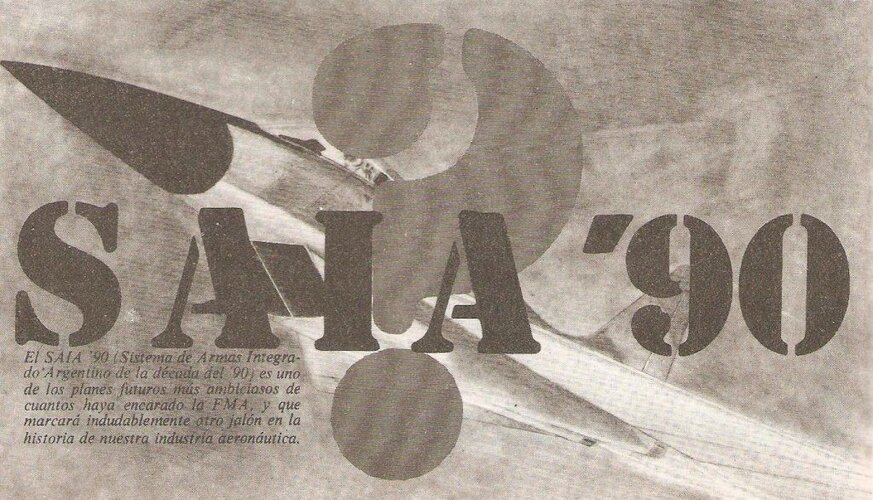
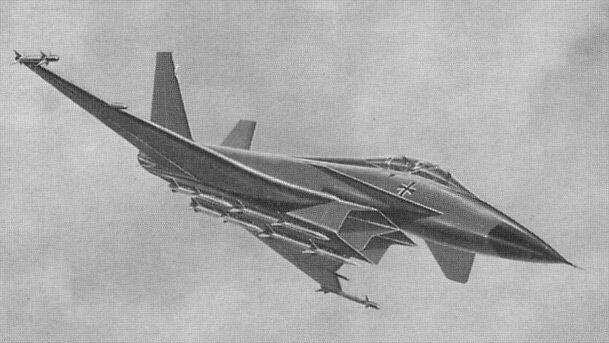
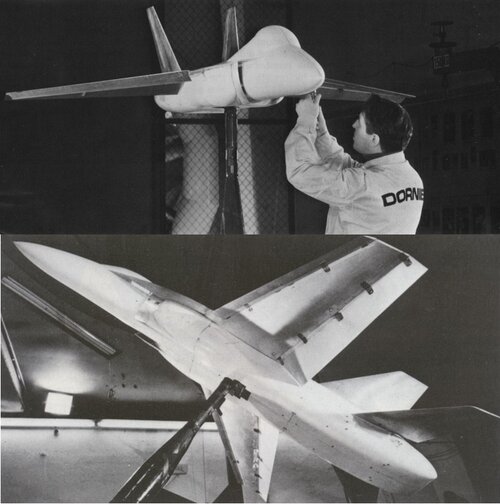
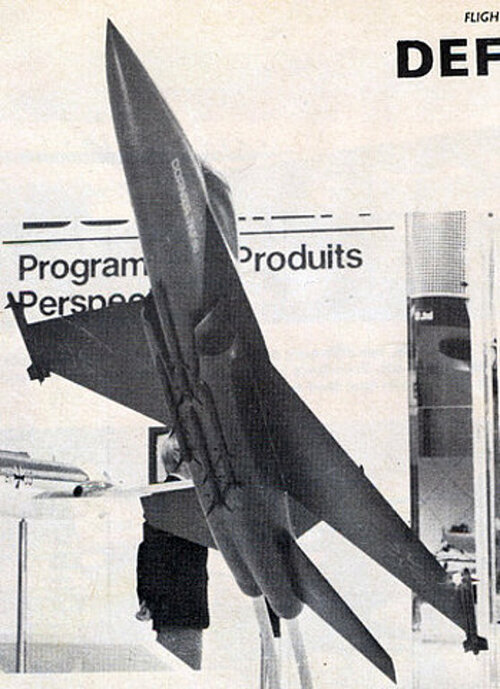
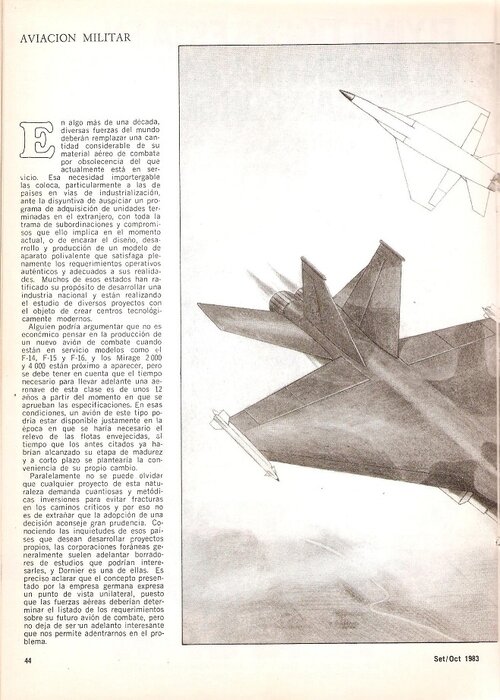
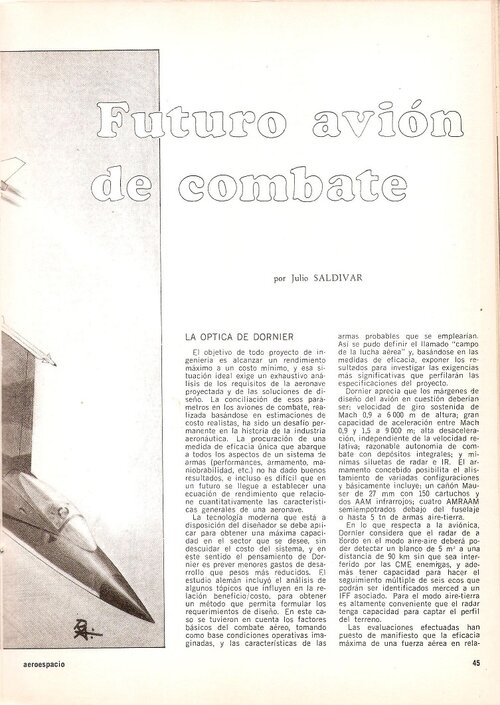
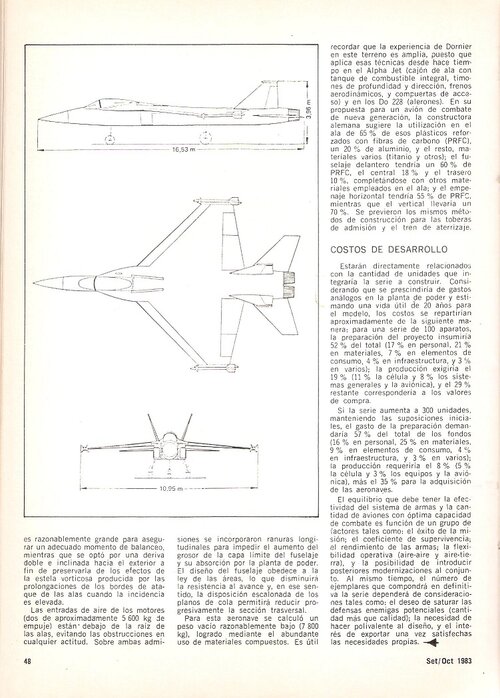
The SAIA 90 cutaway is not even vaguely official, it looks like its an edited P.530 Cobra cutaway done by forum member @Motocar.
Yes. All the hypothetical illustrations of the SAIA-90 were based on the models that Dornier was developing and presenting throughout the 80s for the different German and European fighter programs that would eventually give rise to the Eurofighter Typhoon.
Advertising appeared in the magazine Aeroespacio number 422 of July - August 1981. Compare with that of the MBB TFK-90
View attachment 693154
MBB TKF-90
View attachment 693155
The Dornier TFK-90 project, one of the many fourth-generation fighter projects developed in West Germany in the 1980s, was the inadvertent cause of the birth of the SAIA 90 legend.
View attachment 693156
The model of the TKF90 presented by Dornier, on which the "last known configuration" of the SAIA 90 is based. Many times, in Argentine websites and forums they put this photo as if it were the SAIA-90. Note the similarity with the F/A-18, a product of Northrop cooperation (Photo: Dornier).
View attachment 693157
And a note from Aeroespacio about the future Dornier fighter, from which the urban myth of the appearance of the SAIA 90 is born. I suppose that based on futurology and the musings of some clueless about what FMA could have gotten on this project, which was intended to be what today is the Typhoon....highly unlikely
View attachment 693158
View attachment 693159
El corte SAIA 90 ni siquiera es vagamente oficial, parece que es un corte P.530 Cobra editado hecho por el miembro del foro @Motocar.
Sí. Todas las ilustraciones hipotéticas del SAIA-90 se basaron en los modelos que Dornier fue desarrollando y presentando a lo largo de los años 80 para los diferentes programas de caza alemanes y europeos que finalmente darían lugar al Eurofighter Typhoon.
Publicidad aparecida en la revista Aeroespacio número 422 de julio - agosto de 1981. Comparar con la del MBB TFK-90
[ADJUNTAR=completo]693154[/ADJUNTAR]
MBB TKF-90
[ADJUNTAR=completo]693155[/ADJUNTAR]
El proyecto Dornier TFK-90, uno de los muchos proyectos de caza de cuarta generación desarrollados en Alemania Occidental en la década de 1980, fue la causa inadvertida del nacimiento de la leyenda SAIA 90.
[ADJUNTAR=completo]693156[/ADJUNTAR]
El modelo del TKF90 presentado por Dornier, en el que se basa la "última configuración conocida" del SAIA 90. Muchas veces en webs y foros argentinos ponen esta foto como si fuera el SAIA-90. Nótese la similitud con el F/A-18, producto de la cooperación de Northrop (Foto: Dornier).
[ADJUNTAR=completo]693157[/ADJUNTAR]
Y una nota de Aeroespacio sobre el futuro caza Dornier, del que nace el mito urbano de la aparición del SAIA 90. Supongo que basado en la futurología y las reflexiones de algunos despistados sobre lo que FMA podría haber obtenido en este proyecto, que estaba destinado a ser lo que hoy es el Typhoon ... muy poco probable
[ADJUNTAR=completo]693158[/ADJUNTAR]
[ADJUNTAR=completo]693159[/ADJUNTAR]
Lástima que no sé publicó la página #44 del artículo de la revista Aeroespacio
 www.facebook.com
www.facebook.com
ThanksEl corte SAIA 90 ni siquiera es vagamente oficial, parece que es un corte P.530 Cobra editado hecho por el miembro del foro @Motocar.
Sí. Todas las ilustraciones hipotéticas del SAIA-90 se basaron en los modelos que Dornier fue desarrollando y presentando a lo largo de los años 80 para los diferentes programas de caza alemanes y europeos que finalmente darían lugar al Eurofighter Typhoon.
Publicidad aparecida en la revista Aeroespacio número 422 de julio - agosto de 1981. Comparar con la del MBB TFK-90
[ADJUNTAR=completo]693154[/ADJUNTAR]
MBB TKF-90
[ADJUNTAR=completo]693155[/ADJUNTAR]
El proyecto Dornier TFK-90, uno de los muchos proyectos de caza de cuarta generación desarrollados en Alemania Occidental en la década de 1980, fue la causa inadvertida del nacimiento de la leyenda SAIA 90.
[ADJUNTAR=completo]693156[/ADJUNTAR]
El modelo del TKF90 presentado por Dornier, en el que se basa la "última configuración conocida" del SAIA 90. Muchas veces en webs y foros argentinos ponen esta foto como si fuera el SAIA-90. Nótese la similitud con el F/A-18, producto de la cooperación de Northrop (Foto: Dornier).
[ADJUNTAR=completo]693157[/ADJUNTAR]
Y una nota de Aeroespacio sobre el futuro caza Dornier, del que nace el mito urbano de la aparición del SAIA 90. Supongo que basado en la futurología y las reflexiones de algunos despistados sobre lo que FMA podría haber obtenido en este proyecto, que estaba destinado a ser lo que hoy es el Typhoon ... muy poco probable
[ADJUNTAR=completo]693158[/ADJUNTAR]
[ADJUNTAR=completo]693159[/ADJUNTAR]
Lástima que no sé publicó la página #44 del artículo de la revista Aeroespacio
Ya lo corregí y lo agregué.
También puedes descargarlo desde este grupo de facebook:
Desarrollo Aeroespacial Argentino - Pasado, Presente y Futuro
www.facebook.com
This topic is for Argentine aircraft projects, not for rockets.The Orion research rocket

The public is renewed!From Jane's All The World's Aircraft c. 1980.




 www.zona-militar.com
www.zona-militar.com


 www.zona-militar.com
www.zona-militar.com

The drone is the MQ-2 Biguá developed by Quimar in cooperation with Meteor (Aeritalia) based on the Mirach 100. Together with the launch aircraft and the ground control station it formed the Halcón del Sur reconnaissance system.IA 58 fitted with a drone.
More about Quimar and its drones. The articles are in Spanish and English on each pageThe drone is the MQ-2 Biguá developed by Quimar in cooperation with Meteor (Aeritalia) based on the Mirach 100. Together with the launch aircraft and the ground control station it formed the Halcón del Sur reconnaissance system.
More detail (in spanish) here.
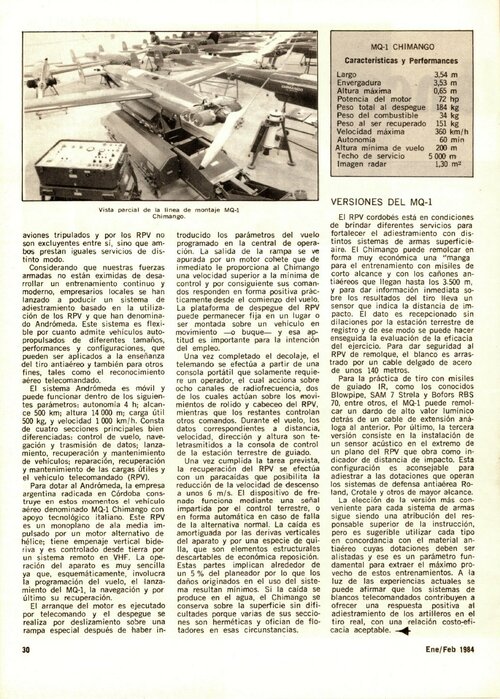
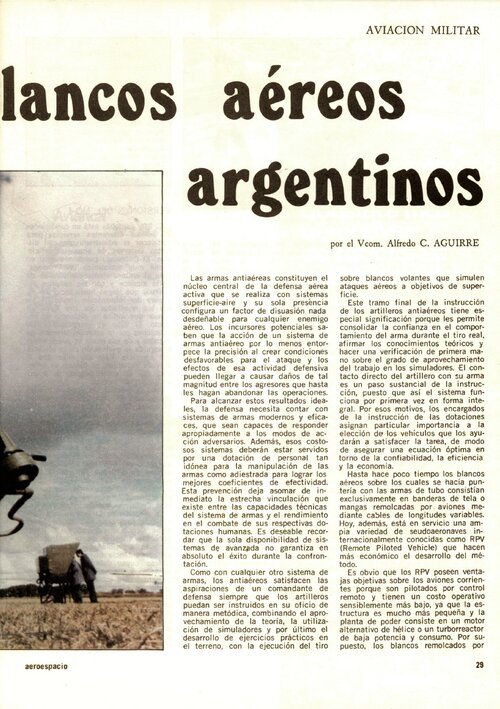
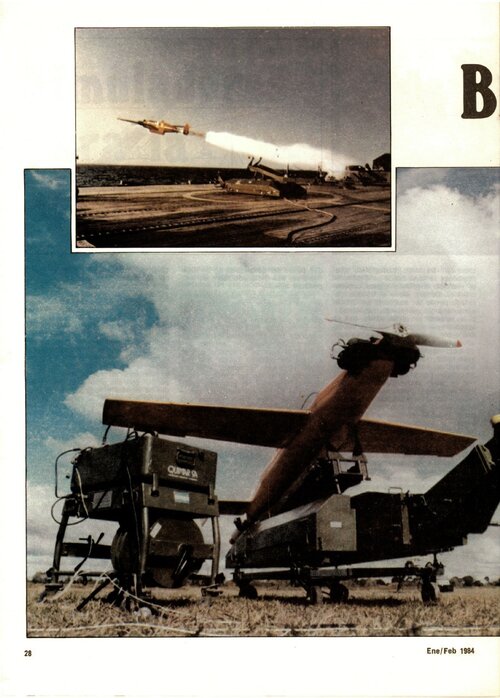
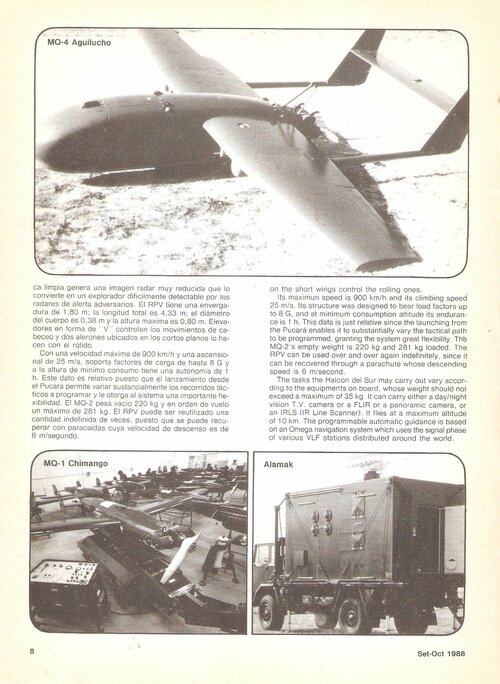
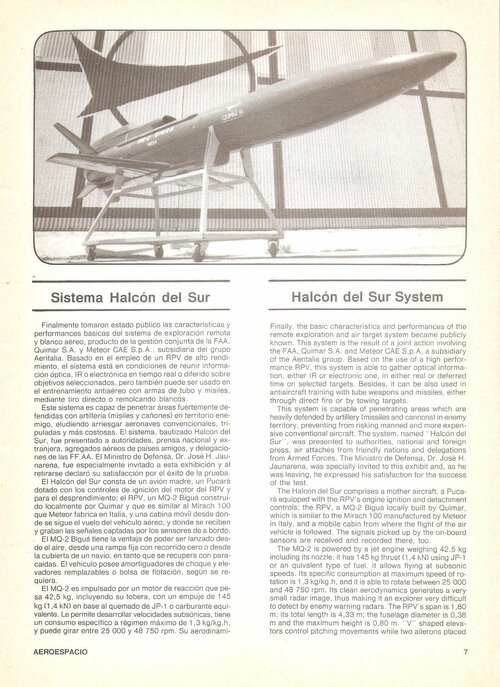


It is the glider version of the IA-58 Pucara, built at the beginning of the program, when the project was known as Delfin, to test its characteristics in flight. They had the advice and help of Reimar HortenDoes anyone know more about this aircraft ?
It looks like a single-seater IA-67.
View attachment 713596
Interesting. It looks heavily inspired by the AMX International/A-11 Ghibli light attack aircraft from Brazil and Italy.Two 3-view drawings of this little-known project of an advanced attack aircraft of the FMA. Originally designated IA-63 Phase 5, then IA-68 in 1984, and again "IA-63 Advanced of Intermediate Attack" in 1989, perhaps because that designation passed to the canceled ATL
FMA IA-68, 1984

A-63 Advanced of Intermediate Attack, 1989

View: https://twitter.com/RengelGonzalo/status/1727703331647156497
This time you've got a drawing of the Pallavicino's Project 1.And now more info on the Pallavicino's projects. They never had any official designation, so they remain known as Project 1 and Project 2.
The Project 1, a radical modification of the IAe-30 Nancu (also designed by Pallavicino) was to be a "heavy fighter", in a class of the Gloster Meteor: one-seater, two Rolls-Royce Derwent V engines each producing 3.500 lb static thrust. The plane was to have been armed with four Hispano-Suiza 20mm automatic cannon.
Here are its specifications:
Wing span: 15,00m
Length: 13,98 m
Height: 4,383 m
Wing area: 35,3 m2
Empty weight: 4.225 kg
All-up weight: 7.950 kg
Wing loading: 225 kg/sq.m
Max. speed @ SL: 910 kph
Max. speed @ 9150 m: 970 kph
Climbing speed @ SL: 26 mps
Climb speed to 9150 m: 8'22"
Ceiling: 15.240m
3 tons of fuel
range 2.300 km
Project 2 was conceived as a light bomber. Two crew: the pilot and the navigator, who was to be seated in a glazed nose or behind the pilot (in such a case the nose would remain solid as in the attached drawing). Armament included four Hispano-Suiza cannon and two bombs of 900 or 1000 kg each in an internal bomb bay. It could also carry twenty 75mm air-to-ground rockets.
Specifications of the Project 2:
Wing span: 18,70 m
Length: 14,00m
Height: 4,65 m
Wing area: 46,65 sq.m
Wing loading: 280 kg/sq.m
Empty weight: 6.500 kg
All-up weight: 13.070 kg
Max. speed @ SL: 810 kph
Max. speed @ 9150 m: 870 kph
Climbing speed: 15,2 mps
Climb time to: 9150 m in 15'55"
Ceiling: 12.200 m
Range with 4 t of fuel and 2 t of bombs: 3.300 km
And finally below you may have a look at the Pallavicino's aircraft drawings (poor quality of the scans is an effect of my scanner's malfunction, for which I am sorry).
[source: Italian magazine "Aero Fan" n. 61, April- June 1997]
Best regards,
Piotr
Interesting. It looks heavily inspired by the AMX International/A-11 Ghibli light attack aircraft from Brazil and Italy.
This time you've got a drawing of the Pallavicino's Project 1.
Source: (Polish) "Militaria" magazine. Special Issue 3 (78)/2023
Can't wait to see this one! Hope it will be possible to order it.Santiago Rivas, a journalist and aeronautical writer well known in Argentina and Latin America, who already published the book on the Pucara in English, is preparing an extensive book in English on the FMA/DINFIA/LMAASA/FADEA that will be published during the course of this year. , so I guess there we will see more plans and images about this and other projects.
The book will cover the period from 1927 to the present.
Not necessarily, the Italians and Brazilians had explored various means of upgrading the powerplant of the AMX. Most of these were generally uprated Speys, RB199 and even EJ200 at one point, but none entered service. Maybe the involvement of Argentina would have changed things. Who knows?I suppose Argentina could have joined that project, but the engine and other components of English origin made it unviable at that time.
I wonder what the ramp of this 'cuatrimotor' really was. Was it an integral airstairs for passangers, something like some variants of Convair 240 did actually have? Or rather was it a real loading ramp for cargo, similar to the Trapoklappe known from transport versions of Ju-290?Study for a transport aircraft with 36 passengers or six tons of cargo. Powered by four "El Indio" engines, it is probably a variant of the IA-47.
The IA-47 was a Kurt Tank project...Hmmm . . . Halifax meets Hermes meets Junkers 290 . . .
cheers,
Robin.
I would have to look at the book "Alas de Peron II" to see what it says about that ramp and the IA-47I wonder what the ramp of this 'cuatrimotor' really was. Was it an integral airstairs for passangers, something like some variants of Convair 240 did actually have? Or rather was it a real loading ramp for cargo, similar to the Trapoklappe known from transport versions of Ju-290?
The ramp seems to be quite wide, too wide for ordinary airstairs imho. So perhaps 'Trapoklappe' hypothesis is more probable (?) and the 'cuatrimotor' could have been used also as a transport plane, even in military roles (vehicle carrying, paratroop and supply drops etc.)
From Interavia 1960,
what was this ?.
